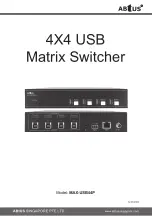
User Re-authentication at Reboot
427
By default, the newly created RADIUS scheme supports the server type
standard
,
while the "system" RADIUS scheme created by the system supports the server type
3com
.
Setting the RADIUS
Server State
For the primary and secondary servers (no matter if they are an
authentication/authorization server or accounting server), if the primary server is
disconnected from the NAS for some fault, the NAS will automatically turn to
exchange packets with the secondary server. However, after the primary server
recovers, the NAS will not resume the communication with it at once, instead, it
continues communicating with the secondary server. When the secondary server fails
to communicate, the NAS will turn to the primary server again. The following
commands can be used to set the primary server to be
active
manually, in order that
NAS can communicate with it immediately after a fault has been resolved.
When the primary and secondary servers are both
active
or
block
, NAS will send the
packets to the primary server only.
Perform the following configurations in RADIUS Scheme View.
Table 461
Setting the RADIUS Server State
By default, for the newly created RADIUS scheme, the primary and secondary
accounting/authentication servers are in the state of
block
; for the "system" RADIUS
scheme created by the system, the primary accounting/authentication servers are in
the state of
active
, and the secondary accounting/authentication servers are in the
state of
block
.
Setting the Username
Format Transmitted to
the RADIUS Server
As mentioned above, the users are generally named in userid@isp-name format. The
part following “@” is the ISP domain name. The Switch will put the users into
different ISP domains according to the domain names. However, some earlier RADIUS
servers reject the username including ISP domain name. In this case, you have to
remove the domain name before sending the username to the RADIUS server. The
following command of switch decides whether the username to be sent to RADIUS
server carries ISP domain name or not.
Perform the following configurations in RADIUS Scheme View.
Table 462
Setting the Username Format Transmitted to the RADIUS Server
If a RADIUS scheme is configured not to allow usernames including ISP domain
names, the RADIUS scheme shall not be simultaneously used in more than one ISP
domain. Otherwise, the RADIUS server will regard two users in different ISP domains
as the same user by mistake, if they have the same username (excluding their
respective domain names.)
By default, the RADIUS scheme acknowledges that the username sent to it includes
the ISP domain name.
Operation
Command
Set the state of primary RADIUS server
state primary { accounting |
authentication } { block | active }
Set the state of second RADIUS server
state secondary{ accounting |
authentication } { block | active }
Operation
Command
Set Username Format Transmitted to
RADIUS Server
user-name-format { with-domain |
without-domain }
Summary of Contents for 5500 SI - Switch - Stackable
Page 24: ...24 ABOUT THIS GUIDE...
Page 50: ...50 CHAPTER 1 GETTING STARTED...
Page 54: ...54 CHAPTER 2 ADDRESS MANAGEMENT CONFIGURATION...
Page 78: ...78 CHAPTER 3 PORT OPERATION...
Page 88: ...88 CHAPTER 4 XRN CONFIGURATION...
Page 122: ...122 CHAPTER 8 VLAN VPN CONFIGURATION...
Page 216: ...216 CHAPTER 15 SSH TERMINAL SERVICES...
Page 268: ...268 CHAPTER 16 IP ROUTING PROTOCOL OPERATION...
Page 308: ...308 CHAPTER 17 NETWORK PROTOCOL OPERATION...
Page 349: ...349...
Page 350: ...350 CHAPTER 18 MULTICAST PROTOCOL...
Page 522: ...522 CHAPTER 22 FILE SYSTEM MANAGEMENT...
Page 584: ...584 CHAPTER 30 PASSWORD CONTROL CONFIGURATION OPERATIONS...
Page 600: ...600 CHAPTER 31 MSDP CONFIGURATION...
Page 614: ...614 CHAPTER 32 CLUSTERING...
Page 670: ...670 CHAPTER C AUTHENTICATING THE SWITCH 5500 WITH CISCO SECURE ACS...















































